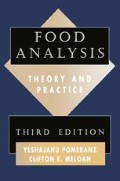Abstract
The most common uses of the principles of conductivity in the analysis of foods are in detectors for ion chromatography, high-performance liquid chromatography, gas chromatography, and capillary zone electrophoresis, Minor uses involve the detection of adulteration of liquids and occasionally the titration of weak acids and bases.
Access this chapter
Tax calculation will be finalised at checkout
Purchases are for personal use only
Preview
Unable to display preview. Download preview PDF.
Bibliography
Benetti, C., Cavalli, S., and Renzetti, R. (1991). HPLC determination of sugars in licorice roots and extracts by using an ion exchange column and amperometric detection. Ind. Aliment (Pinerolo, Italy)30(297), 845–847.
Braunstein, J., and Robbins, G. D. (1971). Electrolytic conductance measurements and capacitive balance. J. Chem. Educ. 48, 52–57.
Clark, D., Wilde, P., and Wilson, D. (1991). Destabilization of alpha lactalbumin foams by competitive adsorption of the surfactant Tween 20. Colloids Surf. 59, 209–223.
Coulson, D. M. (1965). Electrolytic conductivity detector for gas chromatography. J. Gas Chromatogr. 3, 134.
Hall, R. C. (1974). A highly sensitive and selective microelectrolytic conductivity detector for gas chromatography. J. Chromatogr. Sci. 12, 152–160.
Hopper, M. (1991). Analysis of organochlorine pesticide residues using simultaneous injection of two capillary columns with electron capture and electrolytic conductivity detectors. J. Assoc. Off. Anal. Chem. 74(6), 974–981.
Jozef, P., Jager, G., and Cozijnsen, J. (1989). Oxidative stability of chufu and olive oils. Food Sci. Basic Res. Technol. Prog. Proc. Symp. 157–162.
Karovicova, J., and Polonsky, J. (1991). Determination of synthetic colorants by capillary isotachophoresis. Nahrung35(4), 403–404.
Laude, U. T., Naegel, L., and Horn, H. (1991). The physiochemical properties of some Philippine honey’s. Apidologia22(4), 371–380.
Lee, S., and Wylie, P. (1991). Comparison of the atomic emission detector to other element-selective detectors for the gas chromatographic analysis of pesticide residues. J. Agric. Food Chem. 39(12), 2192–2199.
Rights and permissions
Copyright information
© 1994 Chapman & Hall, Inc.
About this chapter
Cite this chapter
Pomeranz, Y., Meloan, C.E. (1994). Conductivity. In: Food Analysis. Springer, Boston, MA. https://doi.org/10.1007/978-1-4615-6998-5_14
Download citation
DOI: https://doi.org/10.1007/978-1-4615-6998-5_14
Publisher Name: Springer, Boston, MA
Print ISBN: 978-1-4615-7000-4
Online ISBN: 978-1-4615-6998-5
eBook Packages: Springer Book Archive

